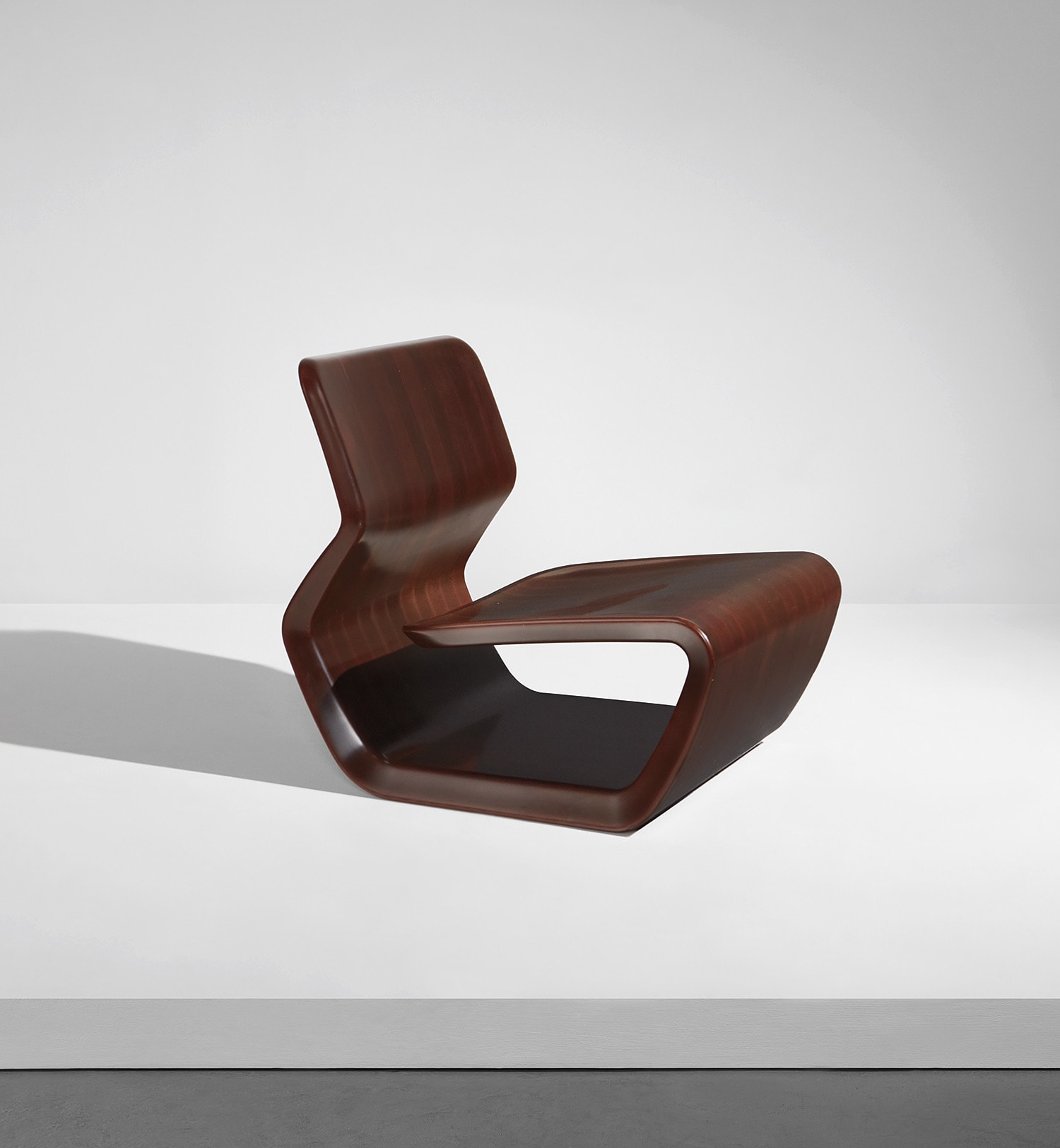

Property of a Private Collector
148Δ
Marc Newson
“Micarta Chair” (Wingless)
2006
Linen phenolic composite.
29 x 245 x 31 1/4 in. (73.7 x 622.3 x 79.4 cm)
Number 7 from the edition of 10 plus 1 prototype and 2 artist's proofs. Underside with metal label signed and impressed 'Wingless/Micarta chair/Marc Newson/ 7 / 10.
Full-Cataloguing
The challenge of creating a chair out of a single uninterrupted material has preoccupied designers throughout the twentieth century. Bent plywood, glass, fiberglass, plastics have all been enlisted, with varying degrees of success. With the design of the present Micarta chair in 2006, Newson cleverly turned the familiar form of these experiments of the previous century inside out, placing a void between the seat and back, rather than the seat and base, implying a flexible seat that is in reality rigid.
Like his later Extrusion works in marble appearing cut from a length, the Micarta chair suggests a cross-section. Its subtly striated rich brown tone presents at first as a polished hardwood, a trompe l’œil effect so often required of new materials in design history, from Formica® to Caesarstone®. This one takes it a step further, as its photosensitivity allows it to develop patina as a natural material might. But there is nothing superficial about Micarta, which combines fiber and resin to create a highly durable material used in a myriad of functional and decorative purposes, from warheads to knife handles. Micarta was developed by George Westinghouse in the early twentieth century, and, while no longer new, it has been re-developed and improved upon for decades. Newson, like Westinghouse, is a pioneer of engineering, materials and processes, though rather than inventing, he often re-visited or re-invented, once saying “…for me, ‘newness’ means taking something out of one context and putting it into another.” Newson did not seek out “new” materials, but he did utilize material developments of the twentieth century and earlier through modern technology, for example, the riveted metal of the Pod of Drawers and Lockheed Lounge, the sculptural upholstery and bent tubular steel of the Komed chairs, and the neoprene of the Embryo chairs.
Design history is often told through narratives of technological progress and marketing. For example, not long after Westinghouse developed Micarta, he promoted it with five cocktail trays designed by George Switzer. The tray was said to be highly durable, resistant to the wear and tear a cocktail set must endure. One hundred years later, Newson did something similar, promoting his Micarta designs on the basis of the material’s qualities–with a slight twist, as the design itself was now the primary product to be marketed.
Like his later Extrusion works in marble appearing cut from a length, the Micarta chair suggests a cross-section. Its subtly striated rich brown tone presents at first as a polished hardwood, a trompe l’œil effect so often required of new materials in design history, from Formica® to Caesarstone®. This one takes it a step further, as its photosensitivity allows it to develop patina as a natural material might. But there is nothing superficial about Micarta, which combines fiber and resin to create a highly durable material used in a myriad of functional and decorative purposes, from warheads to knife handles. Micarta was developed by George Westinghouse in the early twentieth century, and, while no longer new, it has been re-developed and improved upon for decades. Newson, like Westinghouse, is a pioneer of engineering, materials and processes, though rather than inventing, he often re-visited or re-invented, once saying “…for me, ‘newness’ means taking something out of one context and putting it into another.” Newson did not seek out “new” materials, but he did utilize material developments of the twentieth century and earlier through modern technology, for example, the riveted metal of the Pod of Drawers and Lockheed Lounge, the sculptural upholstery and bent tubular steel of the Komed chairs, and the neoprene of the Embryo chairs.
Design history is often told through narratives of technological progress and marketing. For example, not long after Westinghouse developed Micarta, he promoted it with five cocktail trays designed by George Switzer. The tray was said to be highly durable, resistant to the wear and tear a cocktail set must endure. One hundred years later, Newson did something similar, promoting his Micarta designs on the basis of the material’s qualities–with a slight twist, as the design itself was now the primary product to be marketed.